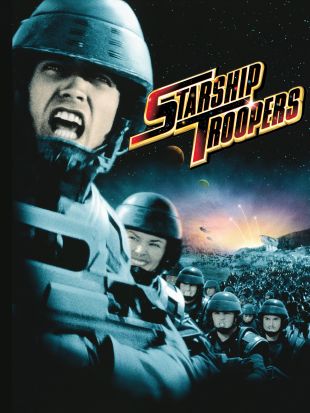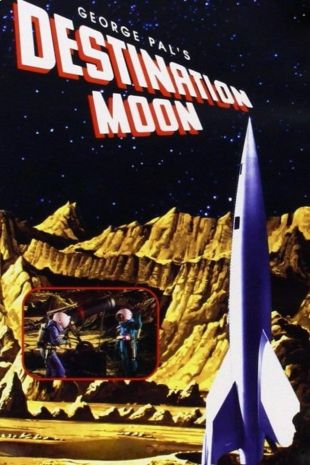Robert A. Heinlein was one of the giants of 20th century science fiction literature and a peer of Isaac Asimov, Ray Bradbury, and Arthur C. Clarke. Though he strongly influenced the direction of postwar science fiction in movies and television, none of the books for which he was most famous were ever adapted to the screen, except in the most superficial manner. Born in Butler, MO, Robert Anson Heinlein was the son of an accountant. As a boy he was fascinated by astronomy and was an avid chess player who also showed remarkable abilities in mathematics. He attended the University of Missouri for one year before entering the United States Naval Academy at Annapolis, ML, in 1925. He was commissioned an ensign upon graduation in 1929, and he later served on the carrier U.S.S. Lexington and the destroyer U.S.S. Roper. Heinlein made lieutenant in 1934, but later that year, he was forced to retire from the Navy when he was diagnosed with tuberculosis. He pursued graduate degrees in physics and mathematics at the University of California. For a while, Heinlein was living on a meager Navy pension and tried supplementing it by managing a silver mine in Colorado; he also got involved in politics and even ran for public office in the California State Assembly in 1938.
Heinlein began writing professionally in 1939, when he sold his first short story, "Life-Line," to Astounding Science Fiction for 70 dollars. He began building a serious following over the next few years as part of the new wave of writers in science fiction's "Golden Age" -- Isaac Asimov, Henry Kuttner, and other giants were gaining popularity at the same time, and Heinlein was there with them, achieving remarkable success in just his first two years. In 1941, he was chosen as the guest of honor and keynote speaker at the World Science Fiction Convention. The outbreak of World War II led Heinlein back into military service as an aviation engineer at the Naval Air Experimental Station in Philadelphia, PA, for the duration of the war. He devoted at least some of his time there to developing high-altitude pressure suits for aviators, which utilized technology that subsequently went into the designs of the first spacesuits for America's astronauts 15 years later.
After World War II, Heinlein was among the first of the new generation of science fiction authors to cultivate a mainstream audience by getting his work published in general interest magazines such as the Saturday Evening Post. He also began writing some works aimed specifically at young adult readers, most notably Rocket Ship Galileo (1947), which became the basis for the movie Destination Moon in 1950. Heinlein's technical training made him uniquely qualified to write about science and scientific principals, and it can be said that some of the appeal of Heinlein's writing lies in his firming up of the science side of science fiction; the fiction side of his work was equally compelling in its embrace and quick presentation of various philosophical ideas, especially politics, in which he tended toward the right. Less obvious but also present in his thinking was a terrible concern for the consequences of the newly launched nuclear age; he and his wife spent years trying to locate themselves a place which they thought would be overlooked as a potential target of Soviet nuclear missiles.
Heinlein won his first Hugo Award for his 1956 novel Double Star and his second in 1960 for Starship Troopers. By the late '50s, however, Heinlein's politics had shifted even further to the right, as reflected in Starship Troopers adapted into a film several decades later, in 1997. Starship Troopers reflected this criticism in its presentation of a future society in which Earth is united in peace and harmony but only those who have served in the military possess full citizenship. His beliefs almost certainly would have collided with the changing social mores of the 1960s if it were not for the publication of Stranger in a Strange Land in 1961. This was the first of Heinlein's books to explore the breaking of social taboos, and it fit right in with the perceptions of younger 1960s readers by attacking accepted sexual and religious conventions and middle-class, middle-brow conceptions of social propriety. It began building an audience beyond the ranks of serious science fiction readers in 1963, and by the second half of the 1960s the book was accepted by the budding counterculture; it was perhaps the second most influential book to come out of the science fiction/fantasy orbit during this period after J.R.R. Tolkien's Lord of the Rings trilogy. There were numerous overtures made by studios and producers interested in filming Stranger in a Strange Land, but Heinlein had lost all enthusiasm for screen adaptations of his work following his experiences during the early 1950s, and for the remainder of his life he stayed clear of such activities.
He would continue to write at a furious rate over the coming decades, most notably with books like I Will Fear No Evil, Friday, Job: A Comedy of Justice, and The Cat Who Walks Through Walls. Heinlein's influence on film and television would be somewhat limited, despite his involvement with various projects for both media. Destination Moon is probably his most straightforward and significant contribution as a source novelist, but it dates from a period in which filmmakers and audiences were very much in sync with his political views. Strangely enough, The Puppet Masters, a story about slug-like alien invaders who take over their human hosts and begin infiltrating the government and society at large, has been his most well-represented book on screen. It has been filmed twice, once without permission by actor/director Bruno VeSota under the title The Brain Eaters (executive producer Roger Corman was unaware of the plagiarism, and a settlement was paid before trial), and in 1994 by Stuart Orme under its own title. The Puppet Masters was also the basis for one of the most harrowing installments of The Outer Limits television series (1963-1965), "The Invisibles." The late-'90s screen adaptation of Starship Troopers was somewhat of a cheat -- it had already been conceived independently as "Bug Hunt," and it was only in the early stages of completing a screenplay that the interested parties recognized some similarities to Heinlein's 1959 novel and purchased the rights. Most Heinlein fans seemed to loathe the movie, as it contained none of the book's element of social criticism and, indeed, almost seemed to burlesque some elements of the story. There were other attempts to film Heinlein projects in the late '90s and beyond, all of which fell through.


